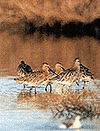 |
 |
|
Story: Roongroj Jukmongkol
Photos: Panote Krairojananan |
|
 |
|
The
Shorebird, usually found treading near or on the shores of bodies of water feeding on the various invertebrates inhabiting the area, derives its name from that area in which it most commonly feeds. And because they have no preference over plain or salt, natural or artificially created bodies of water, they can be found easily throughout the entire continent. Thus, during every winter season, it is not only the Asian Dowitcher that pays a visit to the coastal shores of the Gulf of Thailand, but other varied species of the Shorebird as well. Numbering in the hundreds of thousands, the varying species of the northern Asian Shorebirds journey south from their colder nesting grounds of the Siberian Tundra region, central and eastern Russia, Mongolian desert area, northern China, and even Alaska, to find temporary refuge in these plentiful coastal shores. |
 |
|
Thailand provides a vital refuge to the northern Asian Shorebirds, particularly because it conveniently cuts the journey in half for those traveling the East Asian - Australian Flyway (one of the two routes used for southern migration). Because they must travel a route along food sources (bodies of water), the coastal shores and the surrounding vicinity of the Gulf of Thailand have become a most important and abundant food source and resting station for the Shorebirds, stretching an incredible 195 kilometers and covering an impressive area of seven provinces (Chonburi, Chachoengsao, Samut Prakarn, Bangkok, Samut Sakorn, Samut Songkhran, and Petchburi). More importantly, the four rivers that empty into the Gulf of Thailand carry in their waters additional food sources that are swiftly transported to the coastal shores of the Gulf. |
 |
|
Increasingly, however, the coastal shores of the Gulf of Thailand have been faced with threatening changes. The destruction of the Gulf's connecting forests, although inconsequential to the Shorebirds in the short term, raise long term concerns - the forests have in the past served to protect the coastal shores of the Gulf. Furthermore, the rapid industrialization of the coastal areas of Thailand, sophistication of the fisheries industry in the Gulf, and the resultant toxic wastes being disposed into the waters, will all affect the Gulf's longevity as an important food source and refuge for the Shorebirds. Given these realities, how much longer can the Shorebirds remain a part of the Gulf's shores? |
| |
|
|
|